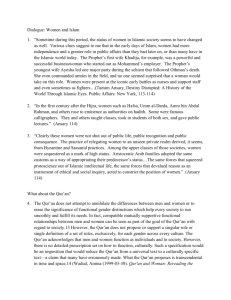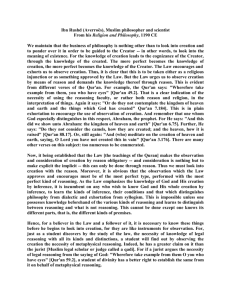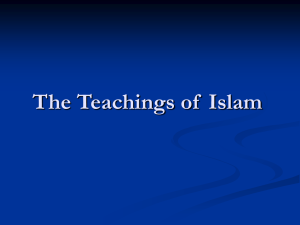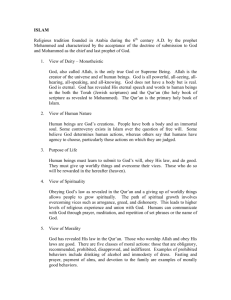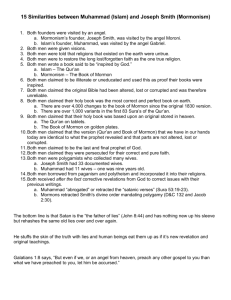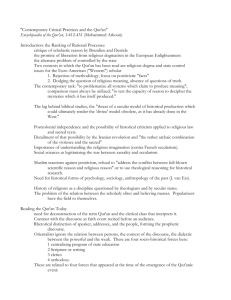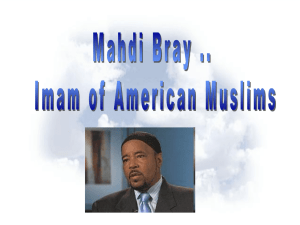Reading the Bible and the Qur'an Together
advertisement
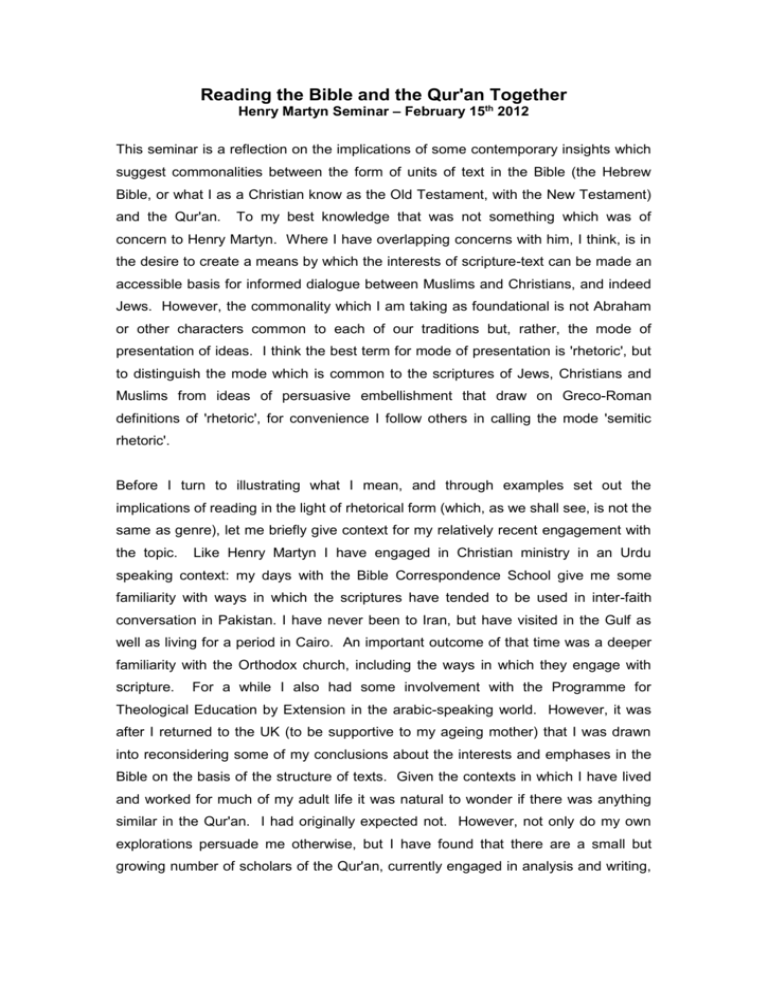
Reading the Bible and the Qur'an Together Henry Martyn Seminar – February 15th 2012 This seminar is a reflection on the implications of some contemporary insights which suggest commonalities between the form of units of text in the Bible (the Hebrew Bible, or what I as a Christian know as the Old Testament, with the New Testament) and the Qur'an. To my best knowledge that was not something which was of concern to Henry Martyn. Where I have overlapping concerns with him, I think, is in the desire to create a means by which the interests of scripture-text can be made an accessible basis for informed dialogue between Muslims and Christians, and indeed Jews. However, the commonality which I am taking as foundational is not Abraham or other characters common to each of our traditions but, rather, the mode of presentation of ideas. I think the best term for mode of presentation is 'rhetoric', but to distinguish the mode which is common to the scriptures of Jews, Christians and Muslims from ideas of persuasive embellishment that draw on Greco-Roman definitions of 'rhetoric', for convenience I follow others in calling the mode 'semitic rhetoric'. Before I turn to illustrating what I mean, and through examples set out the implications of reading in the light of rhetorical form (which, as we shall see, is not the same as genre), let me briefly give context for my relatively recent engagement with the topic. Like Henry Martyn I have engaged in Christian ministry in an Urdu speaking context: my days with the Bible Correspondence School give me some familiarity with ways in which the scriptures have tended to be used in inter-faith conversation in Pakistan. I have never been to Iran, but have visited in the Gulf as well as living for a period in Cairo. An important outcome of that time was a deeper familiarity with the Orthodox church, including the ways in which they engage with scripture. For a while I also had some involvement with the Programme for Theological Education by Extension in the arabic-speaking world. However, it was after I returned to the UK (to be supportive to my ageing mother) that I was drawn into reconsidering some of my conclusions about the interests and emphases in the Bible on the basis of the structure of texts. Given the contexts in which I have lived and worked for much of my adult life it was natural to wonder if there was anything similar in the Qur'an. I had originally expected not. However, not only do my own explorations persuade me otherwise, but I have found that there are a small but growing number of scholars of the Qur'an, currently engaged in analysis and writing, who are presenting evidence for coherency in the interests of large portions, or whole suras, on the basis of rhetorical structure. Henry Martyn was a man of his time. Those of you who attended the first seminar in this series commemorating his life and work will have reflected on that fact. This seminar is of our time in that it is dealing with insights that have been (re-) emerging in the last forty years, and even more recently. Let me summarize. a) A seminal moment in biblical studies was the address given to the Society of Biblical Literature in 1969 by James Muilenburg. In this he stated (1989:8) that: 'What I am interested in, above all, is understanding the nature of Hebrew literary composition, exhibiting the structural patterns that are employed for the fashioning of a literary unit, whether in poetry or in prose, and in discerning the many and various devices predictions are formulated and ordered into a unified whole. by which Such the an enterprise I should describe as rhetoric and the methodology as rhetorical criticism.' Particularly since that time it has become a commonplace in biblical scholarship for such rhetorical criticism to be a primary tool for interpreting scripture text. Amongst important exponents are Phyllis Trible and Walter Brueggemann, who cite Muilenberg as their teacher (Trible, 1984:ix). I will be making reference to them later. b) Fresh observations are still being made and debated in New Testament scholarship. A particularly relevant work is Kenneth E. Bailey's recent Jesus Through Middle Eastern Eyes: Cultural Studies in the Gospels (SPCK, 2008). He insists that understanding of the biblical text is frequently distorted by being read with little awareness of the culture in which it came into being, and that a characteristic of that culture is discourse typified by repetitions, or what literary critics describe as parallelisms, inclusios, chiasms and ring structures. c) Meanwhile, detailed work identifying such structures in the Qur'an began to emerge from the 1980s, but especially since the turn of the millennium: Neal Robinson confesses to having become convinced that chiasmus is an important organizational principle, with implications for interpretation of qur'anic suras, between writing the first (1996) and editing the second edition of Discovering the Qur'an: A Contemporary Approach to a Veiled Text (2003:xiii). A number of scholars working in the area suggest that these are the rhetorical structures in the text which constitute the naẓm that is core to the inimitable nature of the Qur'an (see especially AbdulRaof (2001) and Cuypers (2011)). I suggest that these common developments in the interpretation of our sacred texts should inform the conversations we have around their interests. I have found that typically conversation about subject matter common to the Bible and the Qur'an has tended to deal in isolated units, and so fed the tendency for comparisons to comprise of an exchange of traditional interpretation and exegetical lore, which is certainly a valid inter-faith activity, but one which leaves questions of congruence between the interests of the texts unresolved. The alternative which I propose, of tracking the interests and emphases in textual portions which are identified by tracing word clusters (Leitwort), unifying themes, particular modes of expression, and boundary markers, does often require us to give attention to larger expanses of text. Nevertheless, what I hope to show is that, even though personal bias may impact the interpretive process, the method provides an even-handed way for exploring the congruence of interests of the texts and so a basis for shared, open reflection. To demonstrate the importance of form and rhetoric for understanding our faiths I am using sample texts which feature female characters. I will set out two primary examples from the Old Testament where recognition that the texts are shaped according to principles of semitic rhetoric has invited review of established interpretations. Using figures, in order to be concise, I demonstrate structural relationships within the texts, highlighting their interpretative significance. In each case I supplement the observations by showing parallels and differences in texts with which they resonate, found elsewhere in the Bible and the Qur'an. In this way I hope to illustrate the implications of attentiveness to rhetorical form for across faiths conversation. To provide closing summary I will take one further sura to show how rhetorical form suggests leading interests. As this is an introductory overview intended to show how such an approach might inform our conversations I do not dwell long on fine details. This is not to say that they are not there: evidence of repetition, parallelism and ring structures are found at the macro – whole book or whole sura - level, at the micro – single verse - level, and also at the middle level, so that, for example, there are portions in parallel and rings within rings. Cuypers argues that all analysis must start at the micro level (Cuypers, 2011:5). To demonstrate and explore implications, and to gain a feel for its intuitive impact amongst those for whom the form was 'common sense', I suggest though that it is helpful to be introduced through big picture. To do this I, on occasions, refer to one or other of the seven conventions which social anthropologist Mary Douglas has summarised as characterising semitic rhetoric (Douglas, 2007: 36-38, 126). The importance of rhetorical form: 1. Hannah in the Book of Samuel: I start with this unlikely part of the Hebrew Bible because it illustrates the interpretative significance, in terms of identifying theological interest of a discourse, when rhetorical structure is taken as a major clue to meaning. As it happens it does also have implications for conversations about the presentations of Mary in the Bible and in the Qur'an. Appreciation of rhetorical structures in Hebrew text has, in more recent years, brought into question the long standing conclusion that Samuel-Kings is simply a badly redacted succession narrative (eg., Brueggemann, 1992:219-234, 235-251). Recognition that the final form of the book of Samuel is a ring structure, in which Hannah serves as a major clue to the principle that the humble are raised and the mighty brought low, has contributed to fresh understanding of leading interests in the book The structure shows the book to be theologically sophisticated, with an interweaving of references to those without institutionally sanctioned social, political and religious power, and who are mainly women, which subvert notions of what is important for the outworking of divine purposes. Figure 1: Structure in the Book of Samuel Macro-structure HANNAH problem at the place of sacrifice prayer Hannah’s Song (1 Samuel 2:1-10) [Yahweh, rock, horn, thundering, raising humble, bringing mighty down] Lament: ‘How the mighty are fallen’ (2 Samuel 1:19-27) 'Appendix' (2 Samuel 21-24) Famine David prayed Rizpah’s action prompts honourable action God answers prayer on behalf of the land David’s Song (2 Samuel 22:2-51) [Yahweh, rock, horn, thundering, raising humble, bringing mighty down] Plague David prayed Finally David acts honourably Yahweh answers prayer on behalf of the land • problem • at the place of sacrifice • prayer DAVID Figure 1 sets out the overall structure of the book of Samuel, highlighting correspondence between the story involving Hannah at the beginning and David at the end. It shows the final form to be enveloped by the recounting of divine intervention as 'God answered prayer' (1 Sam. 1:20, 2 Sam. 21:14 and 24:25). The form also enables recognition of a shift in the locus of cultic worship (Shiloh at the start, and the threshing floor of Arunah, later the site of the temple, at the end), allied to the unchanging and emphasised principle that high-handedness results in a fall, whilst humility leads to exoneration. At first glance the book of Samuel is dominated by powerful male characters. It is, however, notable that powerless female characters impact outcomes. (I give one example, but interesting alternatives could have been chosen.) It is noteworthy that none of the male agents who dominate the scene in which Rizpah is introduced actually affect the development of events as they had intended. A woman who has appeared as mere collateral, in the exchanges between Ishbosheth, Abner and David (2 Sam. 3:7), reappears as an agent with resolve whose action impacts the denouement of the narrative (2 Sam. 21:1-14), inviting attentive readers to reconsider the conclusions they have been making as they have progressed through the accounts. Further, the significance of the women is not predicated by their capacity to bear children, though they are characterised by the tendency to protect and value life. Even though Hannah does bear a child who will become an important male leader, her significance in the text arises not simply from her capacity to produce sons but through her independent faith-based initiative expressed in prayer. (These are emphasised in the 'middle-level' and 'micro-level' structures of the opening chapter). The male characters who are counterparts to her story are, much as in other stories of barren women in the Bible (see Alter 1981, 1983), shown by comparison to be (bumbling and) inadequate. Overall, when read in the light of semitic rhetoric, the book of Samuel does not seem to be enamoured of male power, but to provide critique which is nuanced by the interplay of gendered characters, and especially by the initiatives of women to promote, sustain, nurture and protect life. 1.1. Related material for comparative conversation: a) Of Mary in the Gospel of Luke: In the New Testament these intertwined interests of women and of prayer, and the principle that the humble are exalted and the mighty brought low, are particularly picked up in the Gospel of Luke. The Gospel of Luke carries strong allusions to the opening of the book of Samuel and has overlapping theological emphases. These are evident in stories related to prayer (Luke18) and in more numerous matching accounts of women and men, such as the attention given to Anna as well as Simeon (2:25-35), sabbath healings (13:10-17, 14:1-6), parables (eg., 15:1-8, 8-10, being the stories about the lost sheep and the lost coin). The opening chapter evokes various comparisons with events in the Old Testament: the stories of the aged and childless Abraham and Sarah, the birth of Samson, and interaction between Ruth and Naomi, and Deborah and Jael, but especially the story of Hannah and Samuel all find echoes in the accounts of Zechariah, Elizabeth and Mary. It is also, to coin Bauckham's (2002:49) term 'gynocentrically gendered', with the meeting of Mary and Elizabeth at its heart. Significant events in the Temple flank the the first two chapters, whilst events in the central part, in particular the births, are located away from the cultic centre (in hill country, home, desert, inn, and fields). Chapter 1:5-80 Context provided Family Chapter 2:1-42 Context provided (Temple) Family Annunciation (x2) Annunciation Responses Responses Statement (child growing) Statement (child growing) (Temple) Statement (child growing) (Temple) In echoes of the way the story of Samuel's birth creates anticipation of what is to follow (1 Samuel 2:26) the parallel sections culminate with summary statements about the maturing of the children who have been born (Luke 1:80, 2:40,52). The double ending is a characteristic device of ring-structures (Douglas, 2007:126). Mary is the main agent in the opening two chapters. The song she gives voice to after her encounter with Elizabeth echoes that of Hannah in Samuel, setting out themes that will emerge in the narrative to follow, including the theme of reversal: 'He has brought rulers down from their thrones but has lifted up the humble' (Luke 1:52) b) Of Mary in Surat Āl 'Imrān (Q3): Turning to the Qur'an we find there is clear resonance between Surat Āl 'Imrān and the opening of the Gospel of Luke, in that they both give account of the annunciations of the births of John the Baptist (Yaḥyā in the Qur'an) and of Jesus (ʿIsā in the Qur'an). In the sura too, the stories are set in the context of prayer, with women as lead characters, and it also engages with the principle of humility as an attribute of faith. There are echoes of the Magnificat (Mary's song) if not of the songs of Hannah and David [see Figure 3]. The Qur'an scholar, Angelika Neuwirth (2005:244, 2010:528) proposes that the initial influence on Mary's song, in the Gospel of Luke, is a Maccabean war song, whilst the detail in Surat Āl-ʿImrān reflects familiarity with the morning and evening offices of Syriac Christian liturgical services which involve the reciting of the Magnificat and the Benedictus (Zechariah's song, Luke 1:68-79). Rhetorical analysis cannot give categorical response to Neuwirth's proposals (Charlesworth (1982) provides grounds for understanding that it was not uncommon for Jews, and Jewish Christians, of the Second Temple period to rework hymns around traditional themes and phrases). With regard to Mary's song I have already given reasons for recognizing an intentional relationship between the songs in the Gospel of Luke and in the Book of Samuel. Analysis of the sura also suggests purposefulness rather than mere dependency in these qur'anic resonances with Christian material. Figure 3 I Samuel 2 2 Samuel 22 Luke 1 Sura 3:26 He brings low, He also exalts. He raises the poor from the dust, He lifts the needy from the ash heap To make them You save the humble, but your eyes are on the haughty to bring them low.... .... He has brought down rulers from their thrones, And has exalted those who were humble. He has filled the hungry with Say: O God, Master of the Kingdom You give kingship to whom you please And take away the kingship sit with nobles, And inherit a seat of honor; For the pillars of the earth are the LORD's, And He set the world on them He keeps the feet of His godly ones, But the wicked ones are silenced in darkness; For not by might shall a man prevail. Those who contend with the LORD will be shattered; Against them He will thunder in the heavens, The LORD will judge the ends of the earth; And He will give strength to His king, And will exalt the horn of His anointed. The God who executes vengeance for me, And brings down peoples under me, Who also brings me out from my enemies; Thou dost even lift me above those who rise up against me; Thou dost rescue me from the violent man. Therefore I will give thanks to Thee, O LORD, among the nations, And I will sing praises to Thy name. He is a tower of deliverance to His king, And shows loving-kindness to His anointed, To David and his descendants forever. good things; And sent away the rich empty-handed. He has given help to Israel His servant, In remembrance of His mercy, As He spoke to our fathers, To Abraham and his offspring forever. from whom you please. You exalt whom You please and humble whom you please In Your Hand is all the good, And You have the power over everything! On the basis of language and thematic develop I find that the sura has two, almost equally sized, major portions. It shows emphasis at beginning and end on the creedal assertion, lā ilāha illā huwa – 'There is no god but He' (3:2, 6, 18), whilst, at a macro-level, portions in the central material are identifiable by the way the sura addresses Christians and the Muslim community. Figure 3: Structure of Surat Āl ʿImrān (Q3) 1 Alif Lam Mim 2-30 Creed 31-99 People of the Book 31-61 Mary & Jesus (62) Creed Oh 64-99 Abraham (& other prophets) 100-180 Believers 100-120 on relating to People of the Book 121-148 Coping with battle loss Oh 149-189 resisting unbelievers /People of the Book 190-200 Creed The content also shows that, at the time (following the battles of Badr and Uhud), interaction with People of the Book was causing some confusion within the newly formed community. Affirmative statements about the practices of some People of the Book, possibly monks or priests (3:17), and of characters foundational to the Christian account of monotheism, are counter-balanced by warnings about possible negative influence. Structure shows this to be of central concern. However, the kind of deference given to the women characters, Mary and her mother, is unusual in the Qur'an. By implication their prayers affect change. Mary is identified as chosen (iṣṭafāki) above all women (3:42) in a way which associates her with the leading prophets of previous epochs (Adam, Noah, Abraham's family, and the family of 'Imran, chosen (iṣṭafā) 'over all people' – 3:33). Nevertheless, the text makes clear that Mary, the prayerful, was made fit for her chosenness because God made her grow in purity (3:36,37). The earlier phrases which echo the Magnificat also shift all emphasis to the initiative of God: Q3:26 recounts God's sovereignty, stating, 'You give control to whoever you will and remove it from whoever You will; You elevate whoever You will and humble whoever You will...' (Abdel Haleem trans.). The phrase no longer sets out a principle of reversal that gives hope to the marginalised, as found in both Samuel and Luke, but asserts the controlling power of God. To summarise: Consideration of Hannah and the book of Samuel has drawn attention to the way the book carries a critique of leadership through its narrative demonstration that the humble are lifted up whilst those who are high-handed are brought low. Within this (are) women (who) embody the values and concerns of Yahweh. The form and content of the Gospel of Luke echo this. There are continuities in Surat Āl ʿImrān, but also discontinuity created by the emphasis on the initiatives of Allāh. 2. Of the wife of Adam (Eve) and the Book of Genesis: To show that this is not a lone illustration of the impact of interpreting in the light of semitic rhetoric I turn to another portion of the Hebrew Bible, where application of the principles has shifted the contours of debate. I simply summarise detail not usually drawn on when Eve is the focus of comparison. Tribles's 1972 paper on Genesis 2-3 and her book God and the Rhetoric of Sexuality (1978) have had a seminal role in awakening awareness that attention to rhetorical elements in a text affects interpretation. Her attempts to 'depatriarchalise' reading of the Hebrew Bible has also inspired re-reading of the Qur'an by some Muslim women scholars. My understanding of the rhetorical interests of the Genesis material are similar to Trible's, though I have, further, been drawn to conclude that there is an over-arching structure to the whole of Genesis which the opening chapters mirror, and it is on that I want to briefly reflect, as it again highlights the effect of reading in the light of the broader text rather than atomistically. Good (tob) is a key opening term (Genesis 1). Evil (ra') is secondary, and in the denouement the evil enacted by Joseph's brothers is declared to be serving the good which God has been accomplishing (Genesis 50:20). If we recognise Genesis to be in four major portions, the first and the last feature man/ humanity in the image of God/ representing the god king Pharaoh established to exercise dominion over the earth and its produce, whilst the two central portions are especially dominated by the relationship between husband and wife. Likewise, the frame of Genesis 2-4 is the relationship of humanity to humus, adam to adamah whilst at heart is the relationship of man and woman, ish and ishshah: hā'ādām/ha'adāmāh (2:4b-17) - ish/ ishshah (2:18-3:16) - hā'ādām/ha'adāmāh (3:17-24) The Genesis material presents woman as an active and articulate corresponding partner, both valued, and sharing culpability in the breakdown in relationships. The account of the Primal couple, including the incident in the garden, has a certain open-endedness about where blame lies. It sets the scene for dynamics which the ensuing narratives explore. Women are key participants in the unfolding events, not just through child-bearing, but in practical and ethical ways. Notably, in the fourth portion, mirrored words indicate resonance between the story of Eve and the stories involving Tamar and Potiphar's wife. The wit and initiative of Tamar promotes recognition of righteousness (38:26) whilst Potiphar's wife acts wickedly (ra' – 39:9). Importantly the initiative of Tamar triggers the conscience of Judah in readiness for initiatives he will take in the denouement of the Genesis epic. What Genesis establishes about Eve is that she is neither the source of wisdom nor originator of life, but for all that she is an important, that is, integral, participant in the commission to fill the earth and have dominion over it. 2.1. The wife of Adam in the Qur'an There are seven qur'anic accounts which include the refusal by Iblis to bow down to humanity (Q2:30-39, Q7:11-25, Q15:28-43, Q17:61-65, Q18:50, Q20:116-123, Q38:71-85). Five of these refer specifically to Adam, out of which three recall events in the Garden and make reference to Adam's wife. She is not mentioned anywhere else. Structure brings out interests and emphasis in Surat al-Aʿrāf (Q7) and Surat alBaqara (Q2), whilst seeming to corroborate suggestions that in Q20 (Surat Ṭa Ḥa) the account of the deception of the Primal Couple was probably not part of the original sura [Gilliott, 2003:519]. Sura Ṭa Ḥa (Q20): In what is probably the oldest of the three suras the woman is merely an acknowledged presence beside Adam, under threat of the guile of Iblis (Q20:117). She is indicated, also, in the dual form of the verb, sharing in eating from the tree, becoming conscious of being naked and attempting to hide the condition (Q20:121). It is Adam who disobeyed his Lord, and whom his Lord brought back, accepting his repentance, and guiding him. Surat al-Aʿrāf (Q7): There is a rich interweaving of Leitwort in Surat al-Aʿrāf. A recent PhD which explores repetition and the related roles of asymmetry in the Qur'an (Abo Haggar, 2011) has an extensive chapter tracking some of them. The work shows how the multiple examples in the sura work to invite the interpreter to compare and contrast different sections in a rich and coherent presentation of the call to pursue piety and heed guidance. To that I would add observations about the use and distribution of terms referring to place and familial relationships, which give further pause for thought to what is being said about responses of arrogance (istakbara 7:36, 40, 75, 76, 88, 133, cf., 7:13 and 7:206) and rejecting, denying, belying (root kzb 7:36, 37, 40, 64, 72, 89, 92, 96, 101, 136, 146, 147, 176, 177, 182), rather than thankfulness (root Sh-k-r 7:10, 17, 58, 144, 189), toward the message which God's prophets bring. The Garden story comes early in Surat al-Aʿrāf. It opens with the explanation 'Verily, we have established you on earth' (v.10). It has a shift in tone half-way through. The first half (vv. 11-18) tells of humanity's creation and Satan's refusal to bow to Adam. The second (vv. 19-25) takes up the story of Adam and his wife in the words, 'O Adam! Dwell peacefully – uskun – with your wife' (v.19). However, Satan whispers, and being deceived the couple eat from the tree. When they repent, they are both told to get out and warned about enmity they will experience. The story concludes with the explanation 'On earth you will have a place to stay and livelihood – for a time. ... 'There you shall live; there you shall die; from there you will be brought out' (vv. 24, 25). The next section begins with warnings to the 'Children of Adam' (see especially verses 26, 27 and 31) not to be seduced as their parents were in the Garden. The sura is centred. Some repeated phrases serve as section markers. Portions have thematic interests. Various recurring statements indicate a repeated theme, recapitulating elements in the initial story, showing that in succeeding generations there are those who are beguiled and reject God's signs. Some reinforce the sense that this is at Satan's instigation (7:27, 175, 200, 201) The correspondences, with the centring, indicate that the sura is a ring structure: A vv1-9 B Introduction: Book and punished towns vv10-25 creation of humanity, Adam & zawjaha (as comfort), Satan whispers C vv26-58 Children of Adam: exhortation and warning (to) D vv 59-99 E Prophets & resistance (narratives) vv100-102 inherit earth, messengers rejected, towns broke covenant D¹ vv 103-171 Moses: resistance of Pharaoh, and of his own people (narratives) C¹ B¹ vv172-188 vv189-202 A¹ vv203-206 Children of Adam: exhortation and warning (related to) creation of humanity, man & zawjaha (as comfort), Satan prompts Conclusion: pay attention to Qur'an Verse 189 renews thoughts of the original creation: “It is He who created you all from one soul, and from it made its mate (zawjaha) so that he might find comfort (li-yaskuna) in her ...” Here and in verse 19 the sura is presenting a consistent message about the purpose for which the female spouse is created; that her husband might 'yaskun ilayhā'. This has relevance to the discussion initiated by Wadud (1999) and Barlas (2002) about the egalitarian meaning of the word zawja based on Q4:1, an ayah which they insist is not making reference to Adam and his wife. The parallel structure and the detail in the qualifying phrase in this sura (Surat al-Aʿrāf) suggests, contrary to their proposition, that this is what the phrase about nafs and zawj is ultimately alluding to, though not with any intrinsic hierarchical implications. Correspondence creates allusive parallels between the actions of Adam and his wife and other couples. There are some strange aḥādīth related to this (see Spellberg, 1996:314-319), but no narrative developed in the sura. Rather, in the context of other references to familial relationships, this vignette allusively hints at the way false belief has emerged in succeeding generations. The paralleled pieces indicate that there is nothing wrong with marriage, and no blame apportioned to woman. The problem is to do with corporate disobedience and idolatrous associations made. The solution is piety and obedience to the revealed guidance. Surat al-Baqara (Q2): Reference to the wife of Adam comes early in Surat al-Baqara, in a unit of ten verses that tell of the encounter of the couple with Iblis in the Garden (2:30 -39). The preceding material opens with mysterious letters (2:1) and a short section concerned with 'the book' as revelation from God (2:2-7), followed immediately by a section warning of judgement. It is the first such section in the qur'anic canon. It includes a single verse which describes the believers' reward as a paradisical garden in which there are azwājun muṭahharatun - 'pure spouses' (2:25). Thus, in the Qur'an, and in this sura, the first mention of a garden is concerned with rewards of the hereafter, in terms of conjugal relationships. As Robinson (2003:206) observes, 'the gardens, which the believers and their spouses are promised in the hereafter (v.25), represent a return to the blessed state originally enjoyed by Adam and his spouse (v.35).' In recent years a number of scholars have proposed that the material in Surat alBaqara is in parallel sections (Mir, 1993:215-6, Robinson, 2003:203-223, Zahniser, 2000). There are close similarities in their works, with slight divergences in their decisions about the parameters of the Abrahamic material. I think that one reason for this is that they have overlooked the chiastic nature of the sura, which I judge to be centred on the qibla. A Prologue vv.1-29 B Lessons in Story vv. 30-121 founding the'house' vv. 122-141 O children of Israel: C Abraham & the Ka'aba vv. 122-167 vv.142-152 qibla /Ka'aba/ sacred vv. 168-283 vv.153-167 O believers: faith of 'the mosque B¹ Legislation house' A¹ Epilogue vv.284-286 A more recently published proposal by Farrin (2010) finds the same centring. He and I make different decisions about middle-level section divisions in the sura, whilst concurring that formulaic addresses serve as section markers. I base divisions between major sections on recurrent echoes of the primal couple's encounter with the tempter. It is a tricky call as this makes the vision of the eschaton, including of the paradisical rewards of azwājun muṭahharatun, the end of the prologue. What the division draws attention to is the foundational place of the narratival account of the primal couple within the stories recounted. Meanwhile, the juxtaposition of the account in which Adam's wife is identified as his zawja to the vision of the eschaton creates a sense of conjugal bliss as the initial as well as final gift. Verse 35, in which the wife of Adam is introduced, is central to the sub -unit which recounts the couple's encounter with Satan: v30 khalif on earth vv31-33 Adam taught names God who teaches + overcomes human limitations v34 Iblis refused to bow v35 v36 vv37-38 v39 Adam and zawja, in the Garden, eating (taking), 'wrongdoers' Satan made them slip Adam given words God who guides + overcomes human failings inhabitants of Fire The interest in the central verses are taken up in various ways over the rest of the sura. Account of the prophet Adam is followed by accounts of Moses and Abraham. Judgement on 'wrongdoers' is recounted. Legislation is given around the themes of eating, fasting and wealth, but also in regard to women: whether they should be 'approached' in Ramadan, provision in relation to divorce an d widowhood, and about women as witnesses. If these interpretations are correct then the two main quranic references to the wife of Adam draw on the story in different ways. Like the New Testament appropriations (2 Corinthians 11:3 and 1 Timothy 2:13-15) they carry a sense of warning, each in very different ways. The Qur'an gives no sense of the woman as an independent active agent, though the later echoing section in Surat al-Aʿrāf allusively evokes some sense of the compromises and challenges that arise through family life. In summary: The book of Genesis demonstrates God working for good amidst the exigencies of human interactions: it shows humans influencing one another for good and ill. Women are full participants: Eve serves to establish this and to show that women are not inherently the source of life or wisdom. I have not here reviewed 2 Corinthians 11, which provides a lesson for all from Eve's succumbing to deception that led to covetousness driven action, nor 1 Timothy 2, which underlines the necessity for women to learn as it draws parallel with Eve who was not the source of life or wisdom, though I find these to also be centred texts whose interpretation is enhanced by recognition of repetition and parallels. In the Qur'an Adam's wife is, effectively, the silent partner. Surat al-Aʿrāf shows cycles of human disobedience, beginning with the couple in the Garden, and ultimately echoed in a couple somehow committing shirk. At every stage there is a repeated call to obedience and warning of punishment. Surat al-Baqara sets up the relationship between story and legislation: the community is given direction about the management of the provisions Allāh has given in a world where things are not the ideal of Paradise. Each passage recalls Eve for a different purpose. 3. Surat al-Taḥrīm (Q66) – form, leading interests and some conversation starters The distribution of formulaic addresses, and of certain key words and themes gives strong indication that Surat al-Taḥrīm is an integrated whole conforming to principles of semitic rhetoric. This twelve verse sura has the largest concentration of different women characters of any sura. The opening portion makes reference to two of the Prophet's wives who need to repent, whilst the closing portion gives examples of two pairs of women. Of these, the first pair are identified as unbelievers despite being the wives of 'prophets' whilst the second pair do not have such through marriage but are positive examples. privileged status O Prophet – 2 women warned A vv 1-5 O Believers – 'Hereafter': avoid the Fire B v6 O Unbelievers – Fair recompense Today C v7 O Believers – 'Hereafter': attain the Garden B' v8 O Prophet – 2 x 2 women: bad and good examples A' vv 9-12 The central verse, though short, holds the whole sura together. That it is concerned with final judgement confirms observation by Michel Cuypers, who has conducted seminal close study on many suras, that 'the mention of eschatological punishment in the Qur'an is often found in the centre of concentric arrangement', providing the ultimate theological principle, often in terms of judgement (Cuypers, 2009: 195, 205, 464, 469). Not only is the sura a ring structure at the macro-level. The material on each side of the centre, that is middle-level units (vv.1-6, 8-12), are also centred. At heart they emphasise that Allāh reveals. The first unit focuses on the household of the Prophet. It begins and ends with focus on the renewal of the Prophet's familial relationships, with detail on each side of the centre taken up with the behaviour the two wives. The beginning and the ending of the second unit are bound up with prayer based relationship with Rabb. Detail around the centre is to do with eschatological judgement and reward, illustrated through the experiences of women from earlier epochs of monotheism. It typifies the way the final ring takes up key interests from across the whole piece. The text is also structured at the micro-level. I take up the final verse to illustrate. This also enables observation of the common principle in a ring structure that the final element functions as a latch which completes the circle by evoking the beginning. And Mary the daughter of ‘Imrān. A B She guarded her chastity, C so We breathed into her from Our spirit. B¹ She accepted the truth of her Lord's words and Scriptures: A¹ She was one of the devout. There are lots of interesting details in this verse on which I am not going to comment. I am not even going to dwell on the fact that here Mary is not overtly identified in relation to her son. The description ' daughter of ‘Imrān' harks back to the account of her birth in Surat Āl 'Imrān (Q3), and, as Neuwirth and Marx helpfully show, probably echoes associations of Mary with Aaron in Syriac Christian iconography and hymns (see articles in Qur'an in Context (2010), for Neuwirth:499-531, and for Marx: 533-563). The description and associations which we have already observed also associate her with leading figures of previous epochs of monotheism. Here the parallels in the outer envelope (A, A¹) of Surat al-Taḥrīm likewise describe Mary in terms of associations. The internal parallels (B, B¹) take up the nature of her piety, shown in her sexual control and her responsiveness to kalimāt rabbihā wa-kuttubihi, that is, probably, to fresh revelation and previous scriptures. At the centre is the interventionist initiative of God. Concise reference to prayer that expresses desire to dwell in the Garden of Paradise, uttered by Pharaoh's wife, in the previous verse, provides a completion of the immediate business of the section and the sura (cf., Douglas, 2007:126). This final verse continues the flow of both whilst functioning as a latch that completes the circle of the ring structure and extends the reflection into a wider context. The implied associations with key figures of faith from earlier epochs, the specific forms of piety and the interventionist initiative of God are all suggestive of ways of thinking about the Prophet being addressed at the opening of the sura. For those familiar with the asbāb al-nuzūl (occasions for revelation) possibilities posited for this sura: the associations persuade me that it was not honey that the Prophet had denied himself! Indeed, unlike certain contemporary Christian traditions, rather than being used as an icon of the ascetic and celibate life, evocations of Mary here serve to endorse the continuance of marital relations. Amongst the many conversations that could emerge out of these observations are the roles women serve at the beginning and end of portions of scripture. We have already given some thought to the roles that Hannah and Eve serve. The women of Pharaoh's household also feature in the significant opening of the book of Exodus, where the brave resolve and compassion of women is shown to cut across national and ethnic boundaries, laying the foundation for what follows. Meanwhile, it is interesting that in the New Testament, though accounts that include Mary have rhetorical form, other women seem to be situated in the places of major significance. I think this to be the case with the various accounts of the women witnesses to the resurrection at the ends of each of the Gospel accounts: like Hannah they are not merely included in order to recount a chronological history but to establish the leading interests of the text. As such they really ought to have a place in the shared conversations of Jews, Muslims and Christians. Bibliography Abdel Haleem, “Adam and Eve in the Qur'an and the Bible” in The Islamic Quarterly Vol. XLI no.4, 1418/1997, 255-269. Abdul-Raof, Hussein Curzon, 2001. Qur'an Translation: Discourse, Texture and Exegesis, Richmond: Abo Haggar, Dalia University of ProQuest LLC, 2011. Repetition: A Key to Qur'anic Style, Structure and Meaning, Pennsylvania, Ph.D Thesis (2010), Ann Arbor, MI: Alter The Art of Biblical Narrative, London: Allen & Unwin, 1981. “ 'How Convention Helps Us Read: the Case of the Bible's Annunciation Type-Scene', Prooftexts: A Journal of Jewish Literary History, Vol.3. No. 2. (May 1983), 115-130. Bailey, Kenneth E. London: Jesus Through Middle Eastern Eyes: Cultural Studies in the Gospels, SPCK, 2008. Bauckham, Richard Grand Rapids: Gospel Women: Studies of the Named Women in the Gospels, Eerdmans, 2002. Brueggeman, Walter Minneapolis: Old Testament Theology: Essays on Structure, Theme and Text, Fortress Press, 1992. Cuypers, Michel. Convivium The Banquet: A reading of the fifth sura of the Qur'an, Miami, Florida: Press, 2009. '' Qur'anic Text', in 1-24. 'Semitic Rhetoric as a Key to the Question of the naẓm of the Journal of Qur'anic Studies, Vol. 13, (2011), Charlesworth, James H. ‘A Prolegomenon to a New Study of the Jewish Background of the Hymns and Prayers in the New Testament’, in JJS, Vol.33, Nos 1-2 (Spring-Autumn 1982), 263285 Douglas, Mary London: Thinking in Circles: an Essay on Ring Composition, New Haven & Yale University Press, 2007. Farrin, Raymond K. (January 2010), 'Surat al-Baqara: A Structural Analysis', Muslim World, Vol. 100 17-32. Gilliott, Claude Qur'an 'Narratives' in Jane Dammen McAuliffe (ed.) Encyclopaedia of the Vol 3: E- I, 'Leiden: Brill, 2003, 516-526. Marx, Michael. 'Glimpses of a Mariology in the Qur'an: From Hagiography to Theology via Religious-Political Debate' in A. Neuwirth et al. (eds.), Qur'ān in Context: Historical and Literary Investigations into the Qur'ānic milieu, Leiden: Brill, 2010, 533-563 Mir, Mustansir 1986. Coherence in the Qur'an, Indianapolis: American Trust Publications, Muilenburg, James. 'Form Criticism and Beyond' in JBL 88 (1969), 1-18. Neuwirth, Angelika 'Structural, linguistic and literary features', in Jane Dammen McAuliffe (ed.), The Cambridge Companion to the Qur'ān, Cambridge: Cambridge University Press, 2006, 97-113. '' 'Mary and Jesus – Counterbalancing the Biblical Patriarchs: A rereading of sūrat Maryam in sūrat Al 'Imrān (Q3:1-62), Parole de l'Orient 30 (2005), 231- 260. '' 'The House of Abraham and the House of Amram', in A. Neuwirth, N. Sinai, M. Marx (eds.), Qur'ān in Context: Historical and Literary Investigations into the Qur'ānic milieu, Leiden, Boston: Brill, 2010, 499-531. Discovering the Qur'an: A Contemporary Approach to a Veiled Text, Washington, D.C: Georgetown University Press, 2nd Robinson, Neal edition 2003. Spellberg, Denise A. “Writing the Unwritten Life of Islamic Eve: Menstruation and the Demonization of Motherhood” in International Journal of Middle East Studies 28, (1996), 305-324. Trible, Phyllis God and the Rhetoric of Sexuality, Philadelphia: Fortress Press, 1978. Zahniser, A.H. Mathias, 'Major Transitions and Thematic Borders in Two Long Suras: alBaqara and al-Nisā', in Issa J. Boullata (ed.) Literary Structures of Religious Meaning in the Qur'an, Richmond: Curzon, 2000, 2655.
